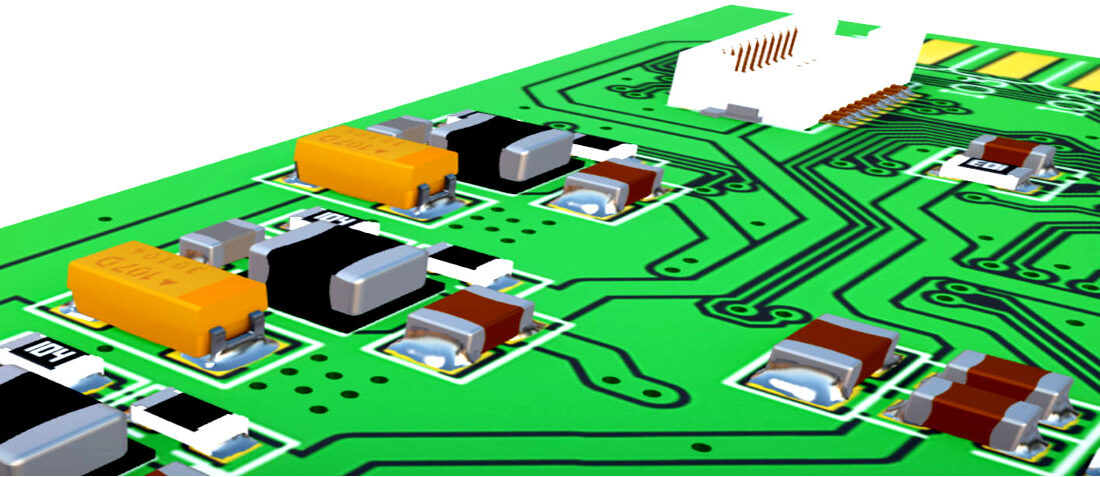
Replacing MLCCs with polymer capacitors
- Posted by doEEEt Media Group
- On December 7, 2020
- 0
With the continuing supply shortage for multi-layer ceramic capacitors (MLCCs), designers are being forced to consider alternatives. In this article, we will look at the factors to be considered if you’re thinking about using polymer capacitors as a replacement.
There has been a supply shortage of MLCCs since the end of 2016 and there are no signs of immediate improvement.
The shortage is caused by the massive growth in mobile electronic devices, automotive electronics and in the Internet of Things, where electronics are embedded in an ever-widening range of products and systems.
It will take time for suppliers to ramp up production of MLCCs. And, in some cases, they may be unwilling to do so because of the risk of being left with excess capacity in the long run. As such, the problem is likely to continue for some time.
Why are MLCCs so attractive?
MLCCs consist of many alternating layers of metal electrode and ceramic dielectric, which enables a large electrode area (and, therefore, a high capacitance value) in a small volume (see diagram below).
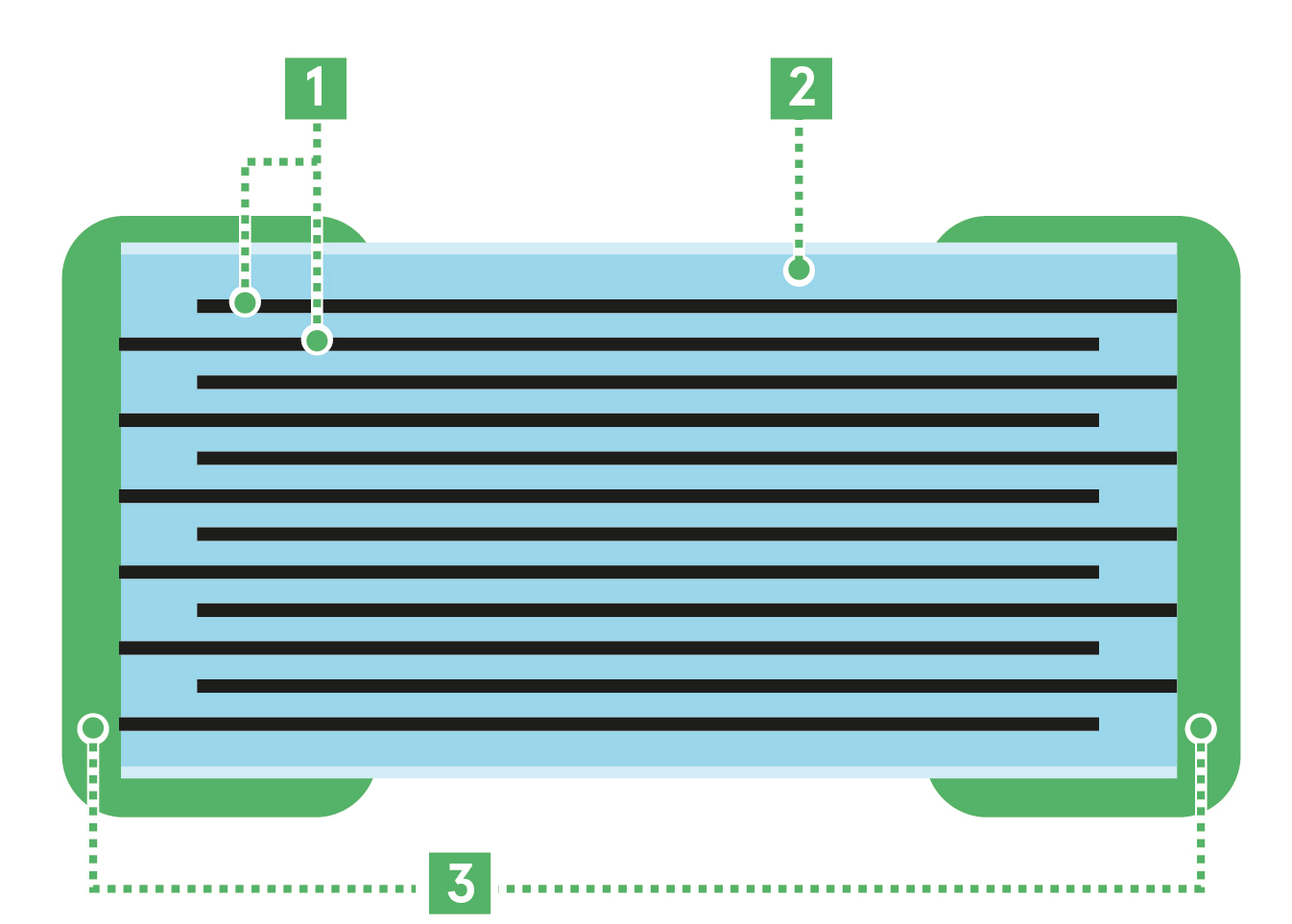
A simple cross-section of MLCC construction [1]
Key:
1 – Metal electrodes
2 – Ceramic dielectric
3 – Connecting terminals
Some of the main advantages of MLCCs are:
- Versatility: Ceramic capacitors are available in a very wide range of capacitance values, spanning nine orders of magnitude. They can also be produced with high accuracy and low thermal sensitivity (class 1 devices) or with greater capacitance values but less accuracy and thermal stability (class 2).
- Small size: MLCCs are surface-mount chip devices and so are compact compared to most other capacitor types, for a given capacitance and voltage.
- Economy: There are no expensive materials required. As a result, ceramic capacitors can, in principle, be produced in large numbers at low cost.
- Durability: Ceramic capacitors are made from durable materials, which are unlikely to wear out over time.
- Safety: There is no risk of leakage, toxicity or combustion as there can be with liquid electrolytes.
- Good electrical characteristics: Ceramics have low parasitic resistance (ESR) and inductance (ESL) – board layout is the largest contributor to the latter in most cases.
As a result, MLCCs are widely used in electronics circuits particularly for decoupling power supplies (this makes up about 70% of the market for MLCCs), filtering noise on input signals, suppressing noise generation and controlling the frequency response of circuits.
Polymer capacitors
Polymer capacitors are a type of electrolytic capacitor.
In traditional electrolytes, one electrode is made of metal and the other is a conductive solution (the electrolyte). Because of this structure, they are polarised, with the metal electrode being the anode (positive) terminal.
The dielectric is formed from a layer of oxide on the metal surface. This is very thin and has a high dielectric constant, meaning that electrolytic capacitors can achieve a high capacitance in a small volume.
In a polymer capacitor, the electrolyte is replaced with a conductive polymer that is deposited on the oxide surface to form the cathode.
Polymer capacitors address some of the issues with liquid electrolytes and also share several characteristics with MLCCs. In particular:
- They are more compact than other electrolytic
- They’re available in surface mount packages
- The absence of liquid means there is no danger of leakage
- The capacitance value is stable over time with changing voltage and temperature
- They have a lower ESR than other electrolytes and hence high ripple current ratings
An incidental benefit of polymer caps is that they are not sensitive to the piezoelectric effects that can cause ceramic devices to either emit sound as a result of AC voltages across them or to pick up ambient sounds as changes in voltage.
The most common use for all types of electrolytes is in power supplies, as smoothing and decoupling capacitors. This is likely to be the main area where they can be used as a replacement for MLCCs.
Switching to polymer
One solution to the MLCC shortage is to find a replacement technology. In some cases, polymer capacitors may be appropriate.
No component is perfect, and every technology requires different trade-offs. Therefore, we need to understand where an MLCC can be replaced by a polymer device, and what parameters need to be considered. As with all engineering problems, this is a matter of finding the right compromises.
There is already some overlap in parameters between MLCC and polymers caps. This includes capacitance range, operating voltage, ESR and packaging. You may be lucky enough to find a drop-in replacement but this isn’t guaranteed so be prepared for some redesign.
In the following sections, we will review the main parameters that need to be considered when you’re deciding whether polymer capacitors will be appropriate in your design. However, there are several different types of polymer caps, which vary both in the materials used and the construction.
The metal electrode can be aluminum, tantalum or niobium. The polymer is normally either polypyrrole (PPy) or polythiophene (PEDOT or PEDT).
These will all have different characteristics and so it will be necessary to look at the detailed specs of any candidate components.
There are some key properties to consider that might let you rule out the use of polymer straight away. These include polarisation, total capacitance, voltage, and ESR. These and others are discussed below.
Polarisation
As polymer caps are polarised, they are instantly ruled out in any circuits where they may experience a reverse-bias or an AC signal.
Capacitance
Electrolytics can have higher capacitance values than ceramics, from a few μF to around 1 mF. This overlaps with, and goes beyond, the top end of values for MLCC capacitors. On the other hand, polymer capacitors aren’t available in the low values that ceramics provide.
The diagram on the right shows the approximate ranges of capacitance and voltage for the two types.
MLCCs can’t achieve the same capacitance in a given volume as polymers. And, because polymers are available in higher capacitance values, multiple MLCCs may be needed to achieve the same value.
You might have had to use multiple MLCCs connected in parallel to reach a certain capacitance value. In this case, due to the higher range of polymer values, it may be possible to replace several MLCCs with a single polymer cap. This could result in both a cost and a space saving.
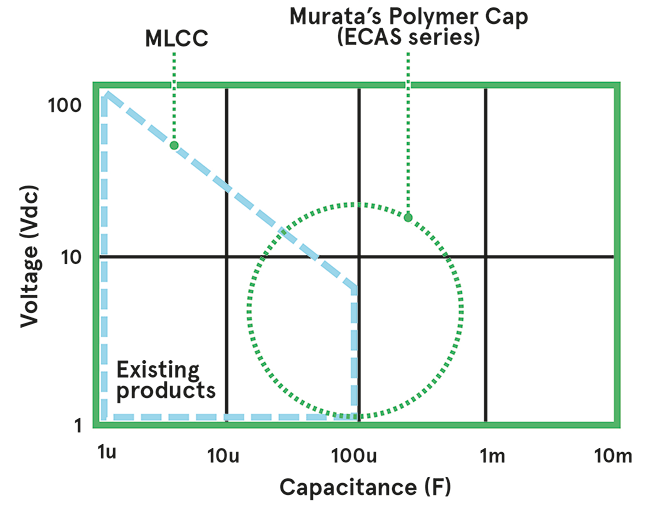
Capacitance and voltage ranges for MLCCs and polymer capacitors [2]
Voltage range
Unlike ceramic capacitors, where voltage ratings can be 100s of volts, the thin dielectric layer in polymer caps means that the maximum voltage is relatively low. The high end is around 35V.
So, if you’re looking for high voltage parts then polymers may be ruled out.
ESR
Ceramic capacitors have very low ESR.
Polymer caps have lower ESR than other electrolytes and are close to MLCCs. This means that you’re less likely to have frequency response or circuit stability problems due to the change in ESR if you switch to a polymer.
However, polymer caps typically have a minimum ESR of around 10 mΩ. If your design depends on ESR less than that, then polymer caps may not be suitable.
Frequency
You may need to consider the frequency response (see diagram below) and, in particular, the self-resonant frequency of the capacitors you’re considering. You generally need to make sure that the caps are being used at a lower frequency than the self-resonant frequency. As a rough guideline, if the signal frequency approaches 1 MHz then you probably need to look carefully at the differences in the frequency response of your capacitors.
Frequency responses for MLCCs and polymer capacitors [3] (Green = polymer caps, blue = MLCC)
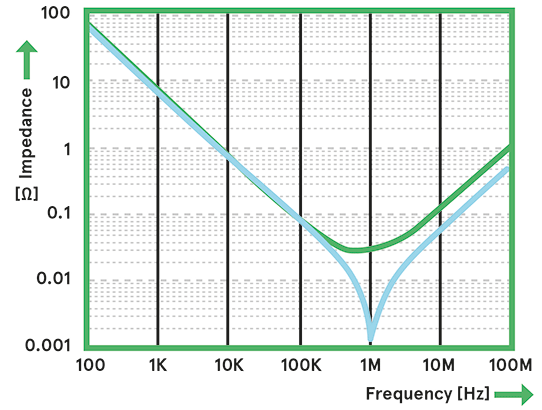
However, both MLCC and polymer caps have fairly constant capacitance with frequency over their operating ranges.
Ripple current
This is mainly an issue in power supply output stages. Ripples in the supply voltage will cause a current through the capacitor, which, in turn, can cause heating.
The heat generated by the ripple current depends on physical characteristics (for example, size and thermal resistance of the package) and the ESR. Both MLCCs and polymers have low ESR and so are far less prone to heating than liquid electrolytes, for example.
The ESR is also stable with temperature so the ripple current limit doesn’t decrease as the temperature rises.
Because MLCCs have very low ESR and generate little heat, the ripple current is often not specified.
Safety
Both MLCC and polymer capacitors are very safe in use. Unlike liquid electrolytes, there is minimal risk of leakage, fire or explosion.
Over-voltage conditions (or reverse bias, for polymer caps) can cause the dielectric break down and hence a short circuit, in both types of devices.
Size and packaging
Both MLCC and polymer capacitors are available as surface-mounted devices and have comparable size for a given capacitance value. Polymer caps are available with larger capacitance values and so may be able to replace multiple MLCCs in less space.
Stability
MLCCs show strong capacitance sensitivity to DC bias voltage. This can cause a reduction in capacitance by up to 70%. Polymer caps are much more stable over time, as shown in the diagram to the right. As a result, MLCCs may need to be derated to allow for this decrease. This isn’t the case for polymer devices.
MLCC vs. polymer capacitor stability over time [4]
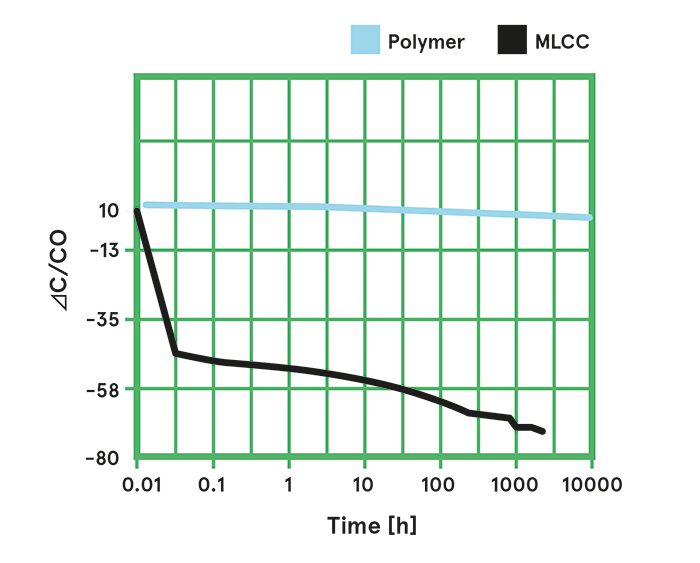
Reliability and lifetime
Because MLCCs are made from brittle materials, there is some vulnerability to thermal or mechanical shock; this is potentially a problem with surface-mounted chip capacitors where circuit board flexing may cause devices to crack and fail.
Polymer caps have a wear-out mechanism where the conductivity of the polymer can be degraded by the effects of heat. This is a small effect but may need to be considered for some applications.
Unlike liquid electrolytics, there is no self-healing mechanism so that any damage caused by transient stresses (over-voltage, for example) will be permanent. Hybrid devices, which include a liquid electrolyte as well as the polymer, provide some self-healing capability for damage caused by transient voltages.
The specified lifetime of polymer capacitors can be several years or decades.
Temperature range
Both types have similar operating temperature ranges. However, the change in capacitance with temperature for the two types is slightly different.
Polymer caps show a steadily increasing capacitance with temperature while ceramics have greater variation, with a peak at around room temperature and then a fall off at higher temperatures. This is shown in the graph on the right.
This may need to be taken into account for higher temperature operation.
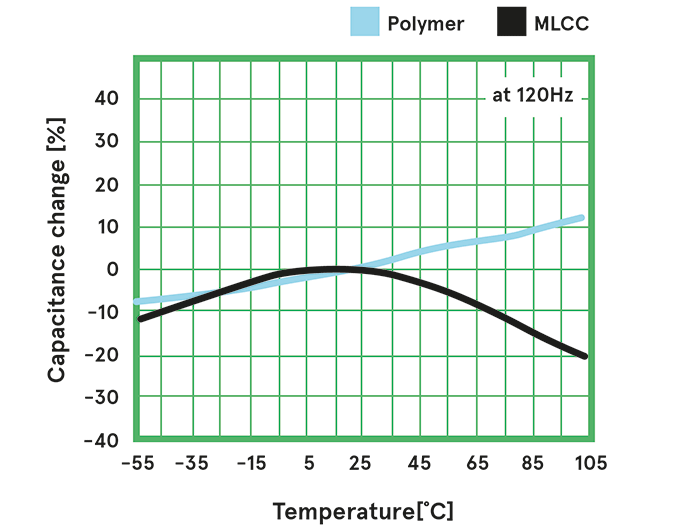
MLCC vs. polymer capacitors capacitance dependent on temperature [5]
Price
Polymer caps may be more expensive, for a given capacitance and voltage, but there is an opportunity for cost saving if you can replace multiple MLCCs with a single polymer of the same total capacitance.
There is less need to de-rate polymer capacitors for changes in capacitance over time so this, again, can be a cost saving.
Replacing MLCCs with polymer capacitors: An example application
One of the most common applications where polymers are appropriate for replacing MLCCs is in power supply decoupling. We can consider a simple example of a DC-DC supply which converts the 12 V input to a 1.8 V supply for the electronics, as shown below.
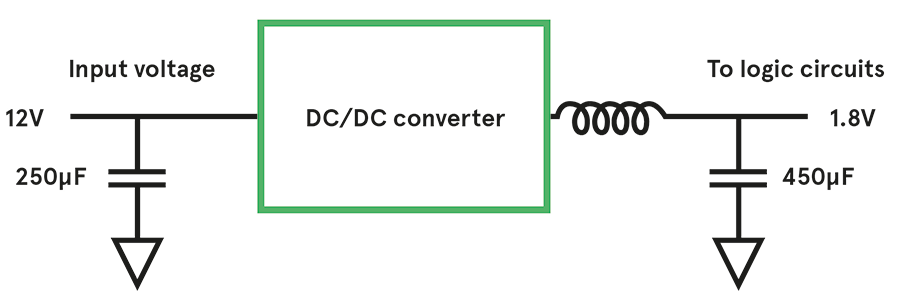
A simple example of DC-DC power supply [6]
This requires 250 μF on the input and 450 μF on the output. The initial design used MLCCs. These need to be de-rated by 70% foraging and DC bias effects. This means we need a nominal 833 μF on the input and 1500 μF on the output.
These values can be realized with 18 capacitors of 47 μF and 15 of 100 μF.
If we replace these with polymer caps, we can use two 150 μF components on the input and a single 470 uF on the output.
The table below summarises the components used and the saving in size:
We can see that the area required for the polymer capacitors is less than half that required for MLCCs. There will also be a cost saving of around 30%.
- Space-Grade components available for immediate delivery - April 10, 2025
- Exclusive stock on doEEEt: How to access and request - April 10, 2025
- Managing EEE components for LEO and lower cost space missions - December 17, 2024

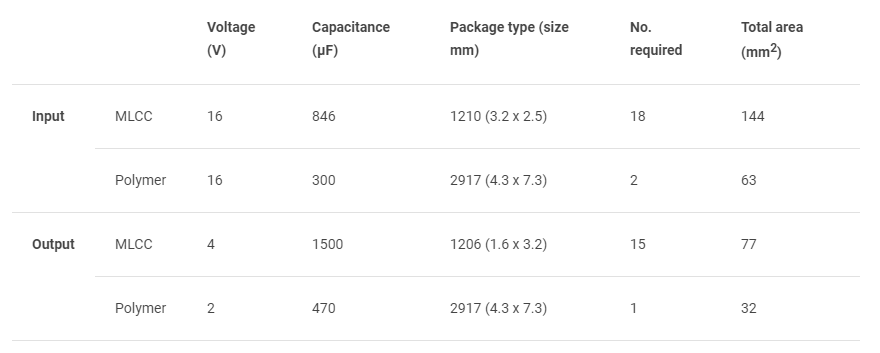

0 comments on Replacing MLCCs with polymer capacitors